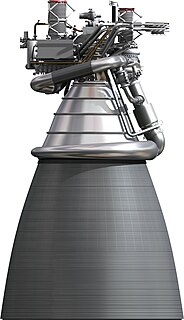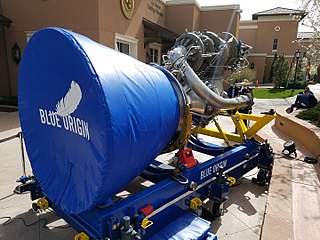Related Research Articles

Rocketdyne was an American rocket engine design and production company headquartered in Canoga Park, in the western San Fernando Valley of suburban Los Angeles, in southern California.

The Aerojet Rocketdyne RS-25, also known as the Space Shuttle Main Engine (SSME), is a liquid-fuel cryogenic rocket engine that was used on NASA's Space Shuttle. NASA is planning to continue using the RS-25 on the Space Shuttle's successor, the Space Launch System (SLS).

The F-1, commonly known as Rocketdyne F1, is a rocket engine developed by Rocketdyne. This engine uses a gas-generator cycle developed in the United States in the late 1950s and was used in the Saturn V rocket in the 1960s and early 1970s. Five F-1 engines were used in the S-IC first stage of each Saturn V, which served as the main launch vehicle of the Apollo program. The F-1 remains the most powerful single combustion chamber liquid-propellant rocket engine ever developed.

The RL10 is a liquid-fuel cryogenic rocket engine built in the United States by Aerojet Rocketdyne that burns cryogenic liquid hydrogen and liquid oxygen propellants. Modern versions produce up to 110 kN (24,729 lbf) of thrust per engine in vacuum. Three RL10 versions are in production for the Centaur upper stage of the Atlas V and the DCSS of the Delta IV. Three more versions are in development for the Exploration Upper Stage of the Space Launch System and the Centaur V of the Vulcan rocket.

Blue Origin, LLC is an American privately funded aerospace manufacturer and sub-orbital spaceflight services company headquartered in Kent, Washington. Founded in 2000 by Jeff Bezos, the founder and executive chairman of Amazon, the company is led by CEO Bob Smith and aims to make access to space cheaper and more reliable through reusable launch vehicles. Rob Meyerson led Blue Origin from 2003 to 2017 and served as its first president. Blue Origin is employing an incremental approach from suborbital to orbital flight, with each developmental step building on its prior work. The company's name refers to the blue planet, Earth, as the point of origin.

Aerojet Rocketdyne Holdings, Inc. is a holding company of Aerojet Rocketdyne, an American manufacturer of rocket, hypersonic, and electric propulsive systems for space, defense, civil and commercial applications. Aerojet traces its origins to the General Tire and Rubber Company established in 1915, while Rocketdyne was created as a division of North American Aviation in 1955.

The Aerojet Rocketdyne RS-68 is a liquid-fuel rocket engine that uses liquid hydrogen (LH2) and liquid oxygen (LOX) as propellants in a gas-generator power cycle. It is the largest hydrogen-fueled rocket engine ever flown.
A liquid rocket booster (LRB) uses liquid fuel and oxidizer to give a liquid-propellant or hybrid rocket an extra boost at take-off, and/or increase the total payload that can be carried. It is attached to the side of a rocket. Unlike solid rocket boosters, LRBs can be throttled down if the engines are designed to allow it, and can be shut down safely in an emergency for additional escape options in human spaceflight.
Aerojet was an American rocket and missile propulsion manufacturer based primarily in Rancho Cordova, California, with divisions in Redmond, Washington, Orange and Gainesville in Virginia, and Camden, Arkansas. Aerojet was owned by GenCorp. In 2013, Aerojet was merged by GenCorp with the former Pratt & Whitney Rocketdyne to form Aerojet Rocketdyne.

The RD-180 is a rocket engine designed and built in Russia. It features a dual combustion chamber, dual-nozzle design and is fueled by a RP-1/LOX mixture. The RD-180 is derived from the RD-170/RD-171 line of rocket engines, which were used in the Soviet Energia launch vehicle and are still in use in the Ukrainian Zenit launch vehicles.

The NK-33 and NK-43 are rocket engines designed and built in the late 1960s and early 1970s by the Kuznetsov Design Bureau. The NK designation is derived from the initials of chief designer Nikolay Kuznetsov. The NK-33 was among the most powerful LOX/RP-1 rocket engines when it was built, with a high specific impulse and low structural mass. They were intended for the ill-fated Soviet N1F moon rocket, which was an upgraded version of the N1. The NK-33A rocket engine is now used on the first stage of the Soyuz-2-1v launch vehicle. When the supply of the NK-33 engines are exhausted, Russia will supply the new RD-193 rocket engine. It used to be the first stage engines of the Antares 100 rocket series, although those engines are rebranded the AJ-26 and the newer Antares 200 and Antares 200+ rocket series uses the RD-181 for the first stage engines, which is a modified RD-191, but shares some properties like a single combustion chamber unlike the two combustion chambers used in the RD-180 of the Atlas V and the four combustion chambers used in the RD-170 of the Energia and Zenit rocket families, and the RD-107, RD-108, RD-117, and RD-118 rocket engines used on all of the variants of the Soyuz rocket.

The J-2X is a liquid-fueled cryogenic rocket engine that was planned for use on the Ares rockets of NASA's Constellation program, and later the Space Launch System. Built in the United States by Aerojet Rocketdyne, the J-2X burns cryogenic liquid hydrogen and liquid oxygen propellants, with each engine producing 1,307 kN (294,000 lbf) of thrust in vacuum at a specific impulse (Isp) of 448 seconds (4.39 km/s). The engine's mass is approximately 2,470 kg, significantly heavier than its predecessors.

The Space Launch Initiative (SLI) was a NASA and U.S. Department of Defense joint research and technology project to determine the requirements to meet all the nation's hypersonics, space launch and space technology needs. It was also known as the 2nd Generation Reusable Launch Vehicle (RLV) program. The program began with the award of reusable launch vehicle study contracts in 2000.
The Rocket City Space Pioneers (RCSP) was one of 29 teams from 17 different countries officially registered and in the competition for the Google Lunar X PRIZE (GLXP) during 2010–2012.

Stratolaunch LLC is an American aerospace company providing high-speed flight test services. It was originally formed in 2011 to develop a new air-launched space transportation system, with its corporate headquarters located in Seattle, Washington. The company and development project were officially announced in December 2011 by Microsoft co-founder Paul Allen and Scaled Composites founder Burt Rutan, who had previously collaborated on the creation of SpaceShipOne.

Dynetics is an American applied science and information technology company headquartered in Huntsville, Alabama. Its primary customers are the United States Department of Defense (DoD), the United States Intelligence Community, and National Aeronautics and Space Administration (NASA).

Aerojet Rocketdyne is an American manufacturer of rocket, hypersonic, and electric propulsive systems for space, defense, civil and commercial applications. Headquartered in Sacramento, California, the company is owned by Aerojet Rocketdyne Holdings. Aerojet Rocketdyne was formed in 2013 when Aerojet and Pratt & Whitney Rocketdyne were merged, following the latter's acquisition by GenCorp from Pratt & Whitney. On April 27, 2015, the name of the holding company, GenCorp, was changed from GenCorp, Inc. to Aerojet Rocketdyne Holdings, Inc.
The Aerojet Rocketdyne AR1 is a 2,200-kilonewton-class (500,000 lbf) thrust RP-1/LOX oxidizer-rich staged combustion cycle rocket engine project.

The Blue Engine 4 or BE-4 is an oxygen-rich liquefied-natural-gas-fueled staged-combustion rocket engine under development by Blue Origin. The BE-4 is being developed with private and public funding. The engine has been designed to produce 2.4 meganewtons (550,000 lbf) of thrust at sea level.

The Boeing Human Landing System (HLS) was the name of a proposed lunar lander concept by Boeing that was submitted by Boeing to NASA on 5 November 2019 as part of the Artemis program and the NextSTEP H. The proposal was presented as the "quickest and simplest method" for a 2024 Moon landing. The lunar lander concept was not selected for funding by NASA as part of Artemis in the 30 April 2020 announcement.
References
- ↑ Stephen Clark (18 April 2012). "Rocket companies hope to repurpose Saturn 5 engines". Spaceflight Now.
- ↑ "The Space Review: Burning thunder".